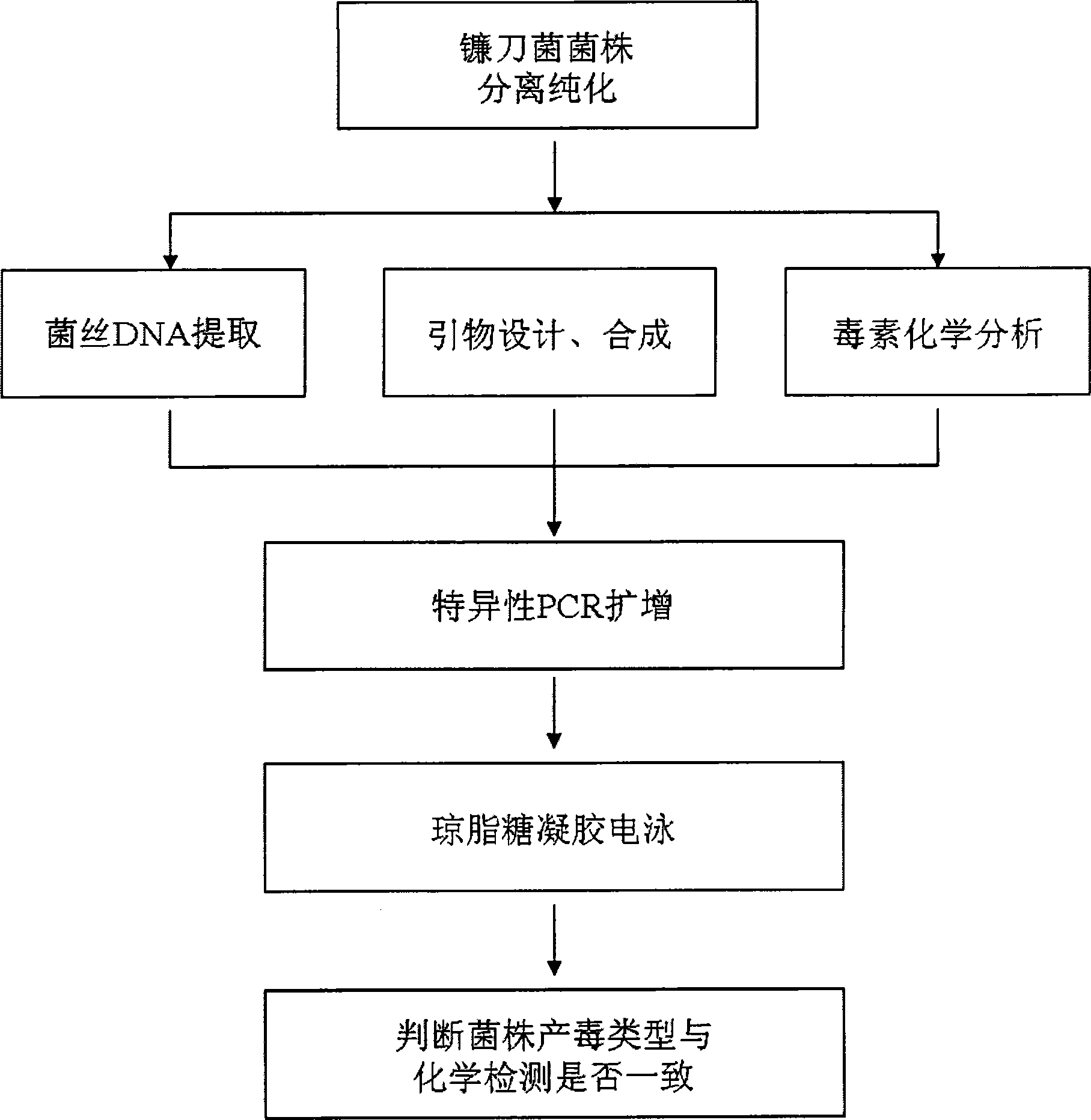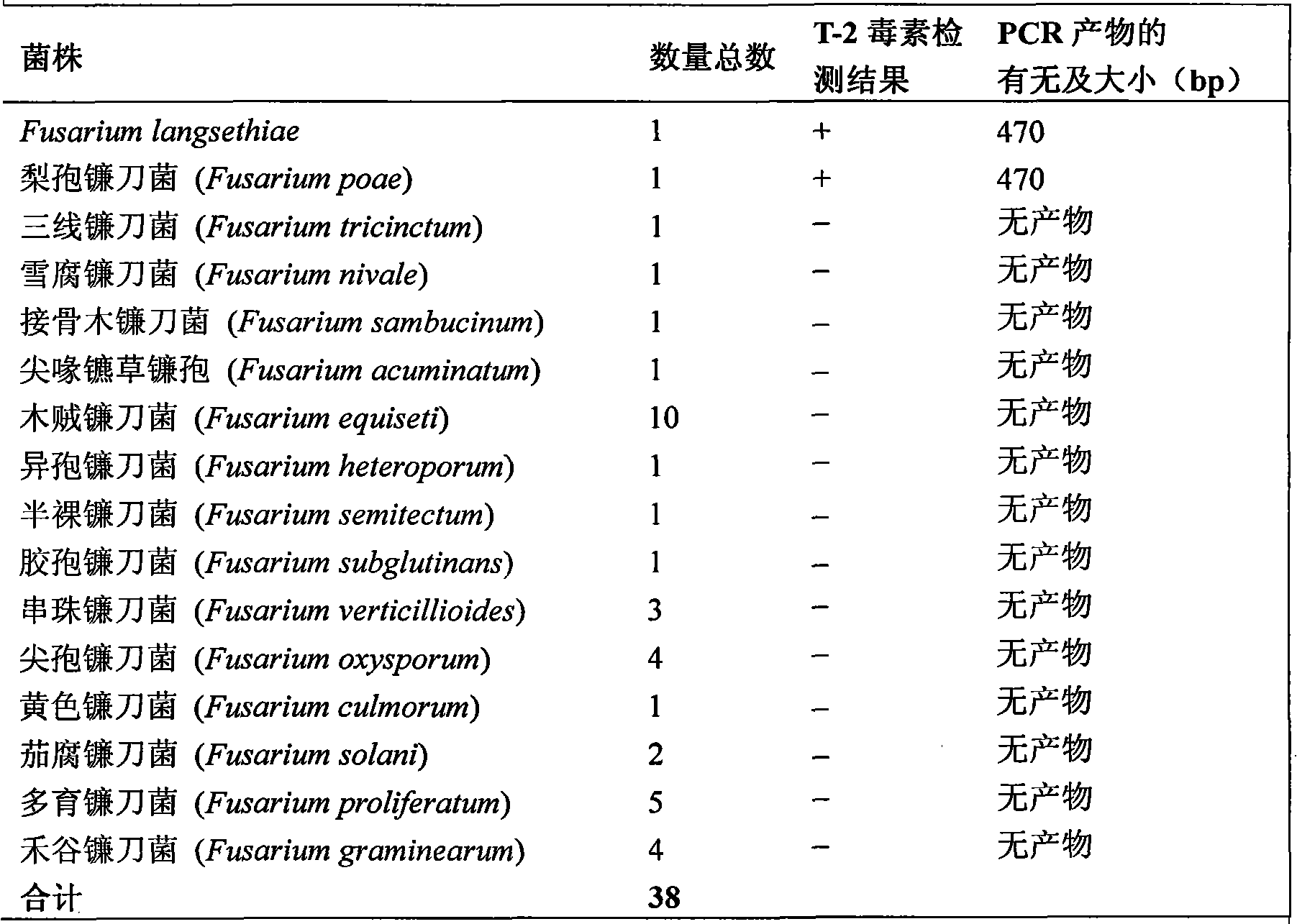Molecular identification method of trichothecene type-A toxins of fusarium
A fusarium and toxin technology, which is applied in the field of molecular identification of fusarium trichothecenes A toxins, can solve the problems that the toxin-producing species have not been verified by chemical analysis, the results cannot be consistent with each other, and the reliability is not high.
- Summary
- Abstract
- Description
- Claims
- Application Information
AI Technical Summary
Problems solved by technology
Method used
Image
Examples
Embodiment 1
[0047] Detection and identification of toxin produced by strain Fusarium langsethiae
[0048] After the strain Fusarium langsethiae (see Table 1) was activated and cultured on the PDA plate for 5 days, a 2 cm diameter hyphae block was punched at the edge of the colony with a punch, and then a 3-point inoculation method (Torp and Langseth, Production of T-2 toxinby a Fusarium resembling Fusariumpoae. Mycopathologia, 1999, 147: 89-96) evenly inoculate the mycelial mass into T-2 toxin induction medium (recipe: yeast extract 20g, sucrose 150g, MgSO 4 ·7H 2 O 0.5g, 20g agar, add distilled water to make the volume to 1L, sterilize at 120°C for 20min before use) on the plate. After the parafilm was sealed, cultured in the dark at 25°C for 14 days. After the culture was ground and crushed by a stirrer, 5 g of the sample was weighed into a 50 ml Erlenmeyer flask, and then 25 ml of acetonitrile-water (volume ratio 84:16) was added, and the culture was shaken and extracted at 150 r / min for ...
Embodiment 2
[0052] Detection and identification of toxin produced by Fusarium poae
[0053] After the strain Fusariumpoae (see Table 1) was activated and cultured on the PDA plate for 5 days, the hyphae block with a diameter of 2 cm was punched at the edge of the colony with a punch, and then a 3-point inoculation method (Torp and Langseth, Production of T-2 toxin by aFusarium resembling Fusarium poae. Mycopathologia, 1999, 147: 89-96) evenly inoculate the mycelial mass into T-2 toxin induction medium (recipe: yeast extract 20g, sucrose 150g, MgSO 4 ·7H 2 O 0.5g, 20g agar, add distilled water to make the volume to 1L, sterilize at 120°C for 20min before use) on the plate. After the parafilm was sealed, cultured in the dark at 25°C for 14 days. After the culture was ground and crushed by a stirrer, 5 g of the sample was weighed into a 50 ml Erlenmeyer flask, and then 25 ml of acetonitrile-water (volume ratio 84:16) was added, and the culture was shaken and extracted at 150 r / min for 16 hours....
Embodiment 3
[0057] Detection and identification of toxin produced by Fusarium culmorum
[0058] Fusarium culmorum (Table 2) strain mycelial total DNA extraction, specific PCR reaction system and amplification conditions are the same as the toxin detection and analysis steps of the strain Fusarium langsethiae in "Example 1". Chemical analysis showed that the strain could not produce T-2 toxin, and PCR amplification did not obtain any fragments. The results are completely consistent. The effect of the invention is as follows figure 2 The lane 12 is shown.
[0059]
[0060]
PUM
 Login to View More
Login to View More Abstract
Description
Claims
Application Information
 Login to View More
Login to View More - R&D
- Intellectual Property
- Life Sciences
- Materials
- Tech Scout
- Unparalleled Data Quality
- Higher Quality Content
- 60% Fewer Hallucinations
Browse by: Latest US Patents, China's latest patents, Technical Efficacy Thesaurus, Application Domain, Technology Topic, Popular Technical Reports.
© 2025 PatSnap. All rights reserved.Legal|Privacy policy|Modern Slavery Act Transparency Statement|Sitemap|About US| Contact US: help@patsnap.com



